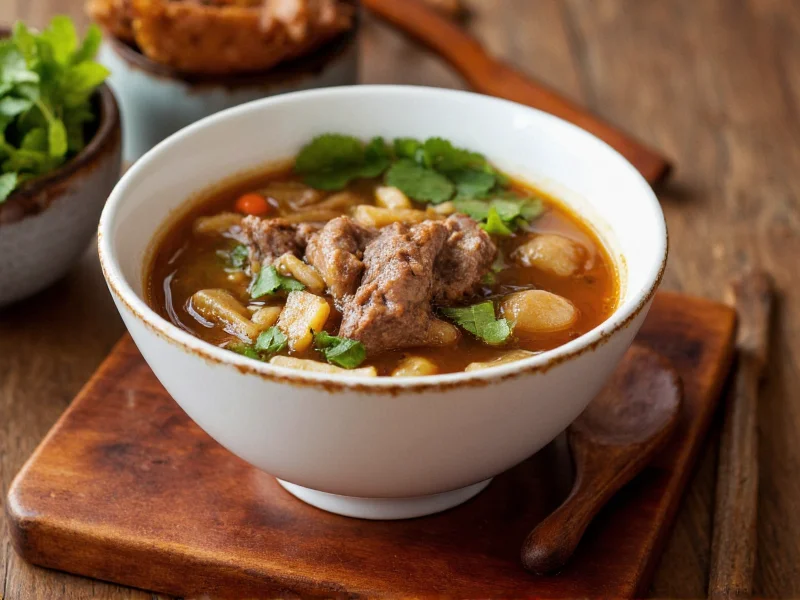The Cultural Heart of Vietnam
Pho emerged in northern Vietnam during the early 20th century, blending French colonial influences with traditional Vietnamese culinary practices. Street vendors originally sold this nourishing meal to workers at dawn, establishing pho's enduring role as Vietnam's beloved breakfast staple. The dish gained international recognition after the Vietnam War, with refugees introducing authentic vietnamese beef noodle soup to communities worldwide. Today, UNESCO recognizes pho as an intangible cultural heritage, reflecting its significance beyond mere sustenance.
Anatomy of Authentic Pho
Creating genuine pho requires precision with four essential components:
| Component | Traditional Elements | Modern Variations |
|---|---|---|
| Broth | Beef bones simmered 8-12 hours with charred onion, ginger, and spice pouch (star anise, cinnamon, cloves, cardamom) | Pressure cooker methods (3-4 hours), vegetarian mushroom-based alternatives |
| Noodles | Bánh phở - flat rice noodles (2-3mm width) | Gluten-free alternatives, varying thickness based on regional preference |
| Meat | Raw eye of round, brisket, flank, tendon, tripe | Chicken pho (phở gà), vegetarian options with tofu and mushrooms |
| Garnishes | Fresh basil, cilantro, sliced onions, bean sprouts, lime wedges, chili peppers | Regional additions like fried shallots, hoisin sauce, sriracha |
Regional Distinctions in Vietnamese Beef Soup
Understanding the difference between northern and southern pho reveals Vietnam's culinary diversity. Hanoi-style pho (phở Bắc) features clear, subtly spiced broth with wider noodles and minimal garnishes, reflecting northern restraint. Saigon-style pho (phở Nam) offers sweeter broth with additional sugar, narrower noodles, and abundant herbs and bean sprouts, showcasing southern exuberance. The traditional vietnamese pho ingredients remain consistent, but preparation techniques and presentation vary significantly between regions.
Mastering Broth Preparation
The foundation of exceptional vietnamese beef soup lies in broth craftsmanship. Professional pho makers follow these critical steps:
- Blanch bones for 10 minutes to remove impurities
- Char whole onions and ginger over open flame
- Create spice pouch with toasted star anise, cinnamon sticks, cloves, and cardamom
- Simmer bones 8-12 hours with spice pouch and aromatics
- Skim foam regularly for crystal-clear broth
- Season with fish sauce and rock sugar to balance flavors
Avoid common mistakes like boiling broth vigorously (causes cloudiness) or skipping the bone blanching step. The best cuts of beef for pho include lean eye of round for raw slices and marrow-rich bones for maximum flavor extraction.
Serving Traditions and Etiquette
Authentic pho service follows specific customs that enhance the experience. In Vietnam, pho arrives piping hot with raw beef slices that cook in the broth's heat. Diners customize their bowl with fresh herbs, bean sprouts, and lime juice before eating. Proper technique involves using chopsticks to swirl noodles while spooning broth, never mixing all ingredients before tasting the pure broth first. Understanding how to eat pho properly transforms a meal into a cultural ritual.
Modern Interpretations and Nutritional Profile
While traditional vietnamese beef noodle soup remains popular, contemporary variations cater to diverse dietary needs. Health-conscious versions reduce sodium while maintaining depth of flavor, and vegetarian vietnamese noodle soup alternatives use mushroom and vegetable broths. A standard bowl of pho contains approximately 350-450 calories, with protein from beef, carbohydrates from rice noodles, and vitamins from fresh herbs. The vietnamese beef soup nutritional information shows it provides substantial collagen from bone broth, supporting joint and gut health when prepared traditionally.
Common Misconceptions
Several myths surround authentic pho preparation. Many believe MSG is essential, but traditional recipes rely solely on natural ingredients. Others confuse pho with other Asian noodle soups like ramen or bun bo hue, though each has distinct preparation methods and flavor profiles. The notion that how to make vietnamese beef broth from scratch requires special equipment is false—only patience and quality ingredients matter. True pho broth should never contain tomato or fish sauce during simmering, though these may appear as table condiments.
Frequently Asked Questions
What makes pho different from other beef soups?
Pho's distinctive qualities come from its clear broth made by simmering beef bones with charred aromatics and specific spices (star anise, cinnamon, cloves), plus the use of flat rice noodles and fresh herb garnishes. Unlike heartier beef stews, authentic pho features delicate, aromatic broth that's been carefully clarified during preparation.
Can I make authentic pho without a pressure cooker?
Yes, traditional pho requires slow simmering for 8-12 hours to extract maximum flavor and collagen from bones. While pressure cookers reduce time to 3-4 hours, they can't replicate the nuanced flavor development of slow-cooked broth. Authentic street vendors in Vietnam still use traditional simmering methods for superior taste and clarity.
Why is my pho broth cloudy?
Cloudy broth typically results from boiling instead of simmering, skipping the bone blanching step, or adding cold ingredients to hot broth. For crystal-clear authentic vietnamese beef noodle soup, maintain a gentle simmer after initial blanching, skim foam regularly, and ensure all ingredients are at similar temperatures before combining.
What are the essential herbs for pho?
Traditional pho garnishes include Thai basil, cilantro, sliced green onions, and fresh lime wedges. Bean sprouts and sliced chili peppers are common additions, particularly in southern Vietnam. These fresh elements provide aromatic contrast to the rich broth and should always be served raw to maintain their vibrant flavor and texture.
How do I store and reheat leftover pho?
Store broth, noodles, and meat separately in airtight containers. Broth keeps for 5 days refrigerated or 3 months frozen. Reheat broth to boiling before assembling bowls with fresh noodles and meat. Never store assembled pho as noodles will overcook. Proper storage maintains the traditional vietnamese pho ingredients' integrity for optimal flavor when reheated.











 浙公网安备
33010002000092号
浙公网安备
33010002000092号 浙B2-20120091-4
浙B2-20120091-4